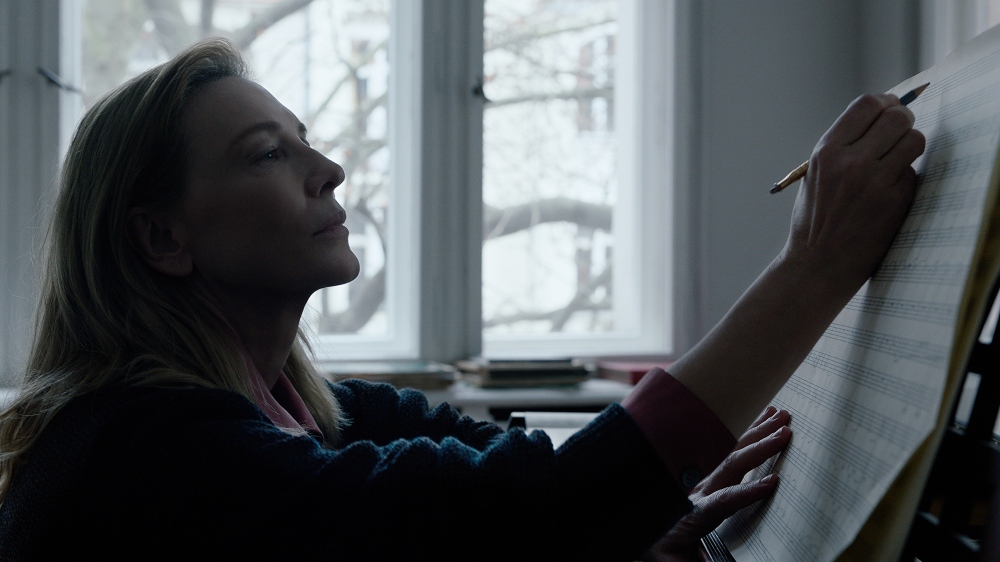
Todd Field‘s drama TÁR, the director’s first feature in 16 years, is a must-see thanks to Cate Blanchett‘s towering performance alone, but the film’s other standout element is its cinematography, courtesy of Florian Hoffmeister.
Blanchett stars as Lydia Tár, a world-renowned composer who’s on top of the world when certain allegations are made against her and her kingdom begins to crumble. Charting her meteoric rise and stunning fall, TÁR charts the evolution, or lack thereof, of one of the greatest (fictional) composers ever.
Hoffmeister’s cinematography, while restrained in certain sequences, gets a chance to shine in a number of others, including a concert hall sequence and the final shot of the film.
Below the Line recently spoke with Hoffmeister, who has been busy filming the new season of True Detective in Iceland, about his approach to TÁR, shooting in a number of beautiful concert halls, and working with both Field and Blanchett.
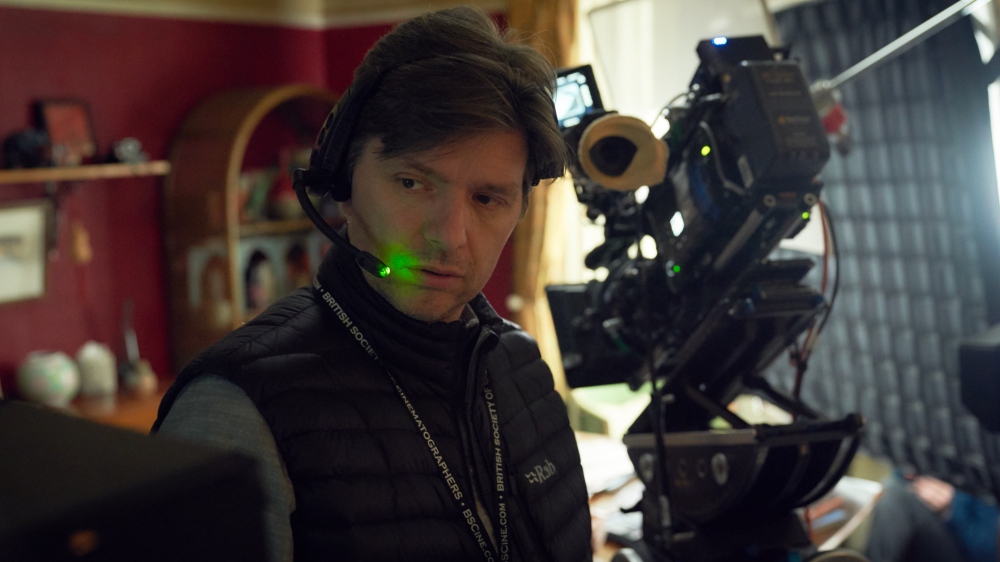
Below the Line: How and when did you first become involved with this project?
Florian Hoffmeister: It was quite an immediate [process]. I think we started prep in July and it must have been April [when] I was still in Vancouver, [where] I was finishing this Apple series, Pachinko.
A mutual filmmaker had introduced me [to Todd Field] — it was clear that Todd was looking for somebody — and I don’t really know the backstory [of the film], but we talked, and then he sent me a script, and then we talked again. It was quite apparent that if the film [went] ahead, we would work together. I pretty much got involved in the project, say, two months before we started prep; maybe three months.
BTL: Obviously, cinematography involves so much more than shooting, as some of the DPs I’ve spoken to say they’ve participated in location scouting, so did you do any of that with this film?
Hoffmeister: That’s the natural cause of things. So basically what happened is, I think we all started together. It was early July, Todd had been there, I think, a few days before, [and] the production designer, of course, had started a bit earlier because they had done some scouting [and] he had sent some references; and then the first thing you do [is] you location scout, and because the film was shot almost entirely on location — even if we were building sets, they were built into, not stages — that process took a long time. I think we were scouting for roughly six to eight weeks.
It took a big part of the prep because it was just important. You know, when you search for locations, they’re like characters. Of course, sometimes the architectural nature of things [plays a factor] and you [have to] think about practicalities and how to move the camera, but sometimes it has to feel like the place where whatever is needed can take place.
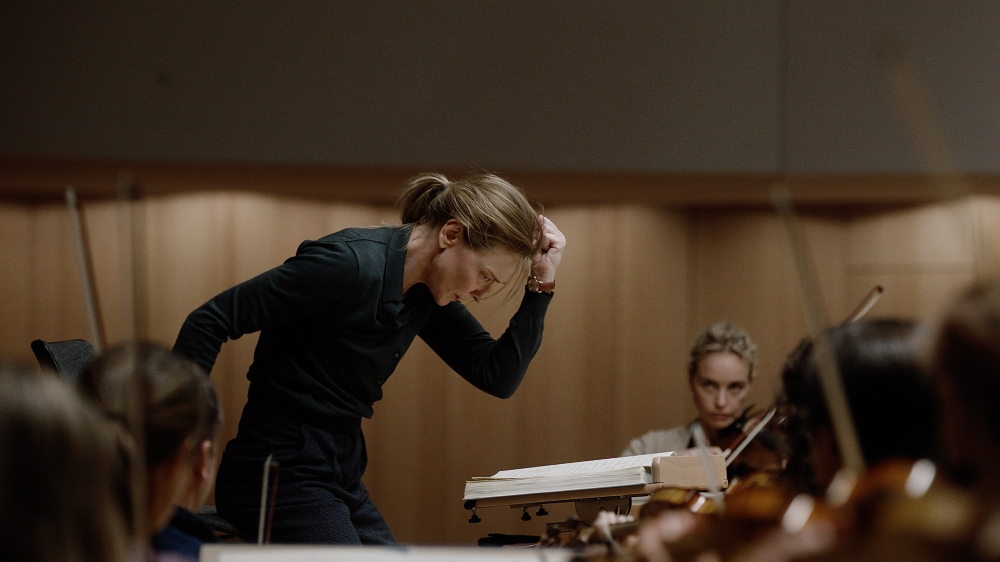
BTL: It sounds like it was all kind of a quick process, but do you remember some of the first conversations you had with Todd Field? What was your mission early on as the film’s cinematographer?
Hoffmeister: When I read the script, I was really struck by [the] combination of a very intimate knowledge of the subject of classical music, of conducting, of the entire pressure-[filled] artistic expression in this medium, and at the same time, the script also had a form of detachment. It’s almost like a clinical process that took place and because [of] this, I felt this detachment [and] it then opened the perspective onto a whole different dimension that was lying under the process.
I think as a cinematographer, it’s all about the intent. What do I want? How do I put my craft into the service of Todd’s script and his directorial approach? So it was clear from the beginning that the cinematography should have some form of precision that would not necessarily tell that story [or] the secondary one — the even more important one — but would create frames in which that secondary feeling could probe almost by itself, because it would’ve been very easy to make a film where the cinematography would’ve put a strong form of judgment onto the character.
[Take] the moment when she fires her assistant. We could have tracked into the face of the assistant. There are so many ways that we are very accustomed to, by [way of] movement, guiding the emotion of the audience, and I think that would’ve been a great disservice to the script. I think it was very clear that we have to have a precision that would be able to reveal the underlying story to the audience themselves so they could decipher it themselves, if that makes sense.
BTL: Speaking of the precision of your work, there are two moments that really stuck out to me that I wanted to talk about with you. The first is that moment before Lydia Tár runs out to the stage in the concert hall. You kind of follow her out of the side of the stage and it almost reminds me of when you see a football player running out of the tunnel — it just had this energy to it that made me feel like I was right there. Did you choose that shot for any particular reason beyond the fact that it’s a memorable image?
Hoffmeister: Yeah, I think you resonate with two things. One was that Todd [and I] talked from the very beginning about [how] he wanted to [portray Lydia’s job, as] there’s a very glamorous element to conducting. All the imagery we know is these glamourous concerts, [but] then we have the rehearsal photography. But the main image in our consciousness is the glamour of the concept, and he was always very adamant that he wanted to create a space in which the work, [in] the form of that rehearsal where 80 people come together and play music, should [have] no glamour in it at all. It’s work. And it’s hard work because they’re all extremely highly specialized, virtuous musicians.
So you have something like the sidepit, and it’s like in a football game [where] you have these back alleys, and we were very adamant to display that as well. I think you resonated exactly [with] our intent [of] including that kind of rehearsal authenticity through the glamourous space of the music performance. The particular shot you talked about was always very clear, and Todd had it in his mind from the very start. When you do a film with that precision, the next decision is, ‘How much do you follow somebody,’ or ‘how much do you make it [into] an editorial process?’
And if you make it into an editorial process, you would’ve shaped our own form of interpretation. To just track in front of her is basically giving maximum space to the emotional experience of her as a character and also giving maximum authenticity and intimacy for us as an audience.
Technically, that was very difficult because we had to get a technocrane — a big piece of machinery — in there, [and to] raise more than a ton to get it into that space was technically difficult. And then to execute the shot [was difficult] because at the beginning, you start on the trumpet and then you come over and you don’t even know that there’s another conductor. So it all plays with this expectation [of] what is actually going on.
And then we had to pull back, and she was, of course, raising her hand, which is then technically [difficult] For many reasons, the depth of field is very shallow, so it’s hard work for the focus. So to actually pull this shot off was quite a challenge apart from the emotional bit that Cate Blanchett was doing.
Although I have to say, for the record, it was a privilege to work with Todd, but it’s an equal privilege to work with somebody like Cate because she’s so dedicated to [her] craft and she’s absolutely focused on getting the best out of every single shot. And she knows that there are a lot of technical elements that have to also work — sometimes in her favor — and she’s happy to go over and over again. So yeah, it was fun. I love that shot as well.
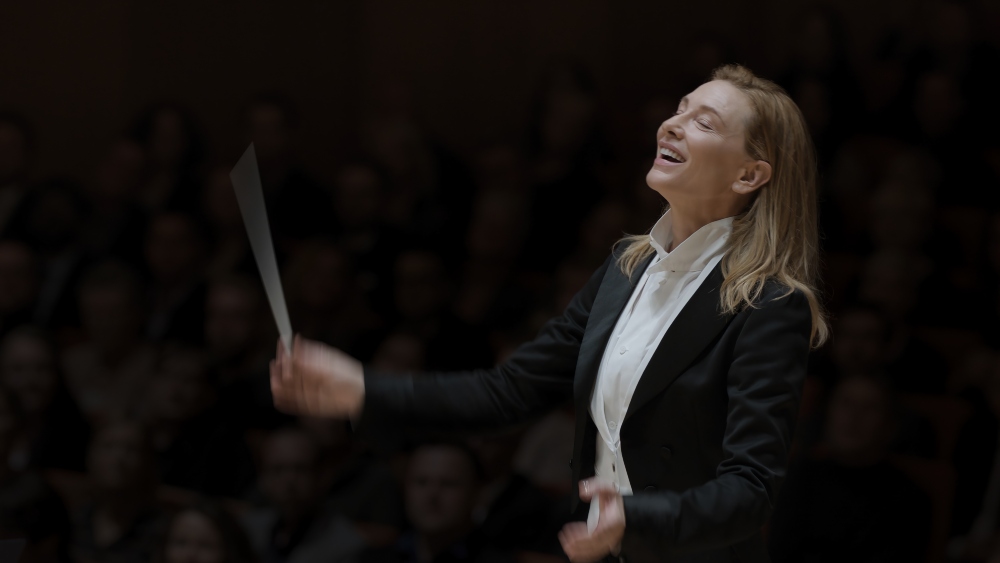
BTL: I’m glad you mentioned the technocrane because when I was watching the film, I remember thinking to myself, ‘I don’t know how he pulled that off,’ because I’d be nervous about hitting somebody while walking backward. I didn’t know if you were doing it manually, but that makes more sense.
Hoffmeister: I think you resonate again in the right way. Because I think in the most ideal world, you could get a feel for how it was executed. It should never try to attract your attention. You know, I have this phrase like, ‘Don’t put a hat on a hat,’ and I think oftentimes [in] cinema, the cinematography can try too hard to almost do the same thing that everything else is doing in the film as a performance. The space will tell a story and sometimes it’s best for us to disappear. And on a film like TÁR, with this form of empirical detachment versus intimate knowledge, I think the key for the cinematography was to be almost invisible. Not invisible in terms of the pleasure it gives you as an audience, but [to] never catch your attention [and] take your attention away from the central bit of the performance.
BTL: Before I pivot away from this scene, what was it like working in such a beautiful orchestra hall? Were there any other difficulties shooting there besides the lack of space?
Hoffmeister: So I live in Germany, but I hadn’t shot there in 15 years. I mostly shoot internationally and it was a really interesting time for me to revisit [and] come back into my own cultural sphere, do the cinematography, and almost re-encounter some of the stuff that I actually know as part of my own cultural DNA.
What you need to know is that in the German cultural sphere, the film industry is highly unregulated. In Germany, we have unions all over Germany, but in the film industry itself, unions are not as strong as in the United States.
However, classical music is a gigantic thing in Germany and it’s the most highly-regulated space in terms of unions and union rules. That starts with very simple things. For example, sheet music [requires] a certain brightness, so the lights above the heads [of the players] have to have a certain brightness so that they can read the sheet music. So we had to negotiate with the orchestra, of course, so we would do a 10-hour shooting day and they would be present in that. Now they never do a 10-hour working day without a lot of breaks because they constantly need to practice, so it would be like, they would be able to be on stage with us for like 30 minutes and after 30 minutes they would need a 10-minute break.
And even though they were just sitting there as an orchestra, that is just the regulation. So they would come on stage, the first violinist would stand up and he would tune the orchestra [and] even though they didn’t have to play in the particular scene, we would do the scene and after 30 minutes they would say, ‘Well, we have to take the break now.’
It was almost like two worlds colliding — that was a really interesting bit. What I really enjoyed is that Todd made the decision to cast some of the orchestra members in the film and we really managed to capture the spirit of what it means to rehearse and the mindsets of these people. It was a real treat to be working with a philharmonic orchestra.

BTL: One other shot that really stood out to me is when Lydia stumbles out of that massage salon in Asia and the camera goes from being still to all of a sudden handheld and shaky once you begin following her, if I’m remembering that correctly.
Hoffmeister: You absolutely remembered correctly [smiles].
BTL: So then I’m curious, what you were trying to convey from your perspective as the cinematographer in this scene and how did you accomplish that shot? It felt so seamless.
Hoffmeister: It was very simple. It was exactly as you described. First of all, never underestimate the audience in how sophisticated people already are in their recognition of filming [and how] they can anticipate what comes next. [With] a film like TÁR that burns so slowly, you have to be super careful not to give away anything too early.
So this is set up as an establishment — it’s like a house. She comes out [of] the house, and then, of course, her emotional state pivots into something [and] we suddenly realize [that] she’s unwell. Then the camera wants to follow her, and then suddenly [it] breaks loose because it’s such an existentialist moment for her. We just take it off the tripod and it becomes handheld — it was very simple. [We were] just sitting there on a tripod and then we ripped it off and ran with her.
But the idea behind it is, ‘always be aware [of] what to tell [and] where we put the focus.’ Say, for example, if you had done it as a crane shot, you already introduced movement. Now, an audience knows [that] this could potentially move, you know? So it’s these tiny decisions, you know — how much do you give away? And Todd always said, ‘Just hold back. Hold back.’
BTL: It’s fascinating to learn so much about the selective decisions that were made in terms of the restraint in your work on this film.
Hoffmeister: I am convinced that you can subconsciously change the reception of a film if your intent isn’t right — you can literally destroy a film. Sometimes it’s hard to find it because it’s not in a clear situation. The script might not have the same clear, precise brilliance of Todd’s script, [or It] might not be as brutal in the execution of that vision. So it is not always easy.
In this case, I think a lot of things lined up that I felt I could really contribute to. That’s what I think is interesting about cinematography.
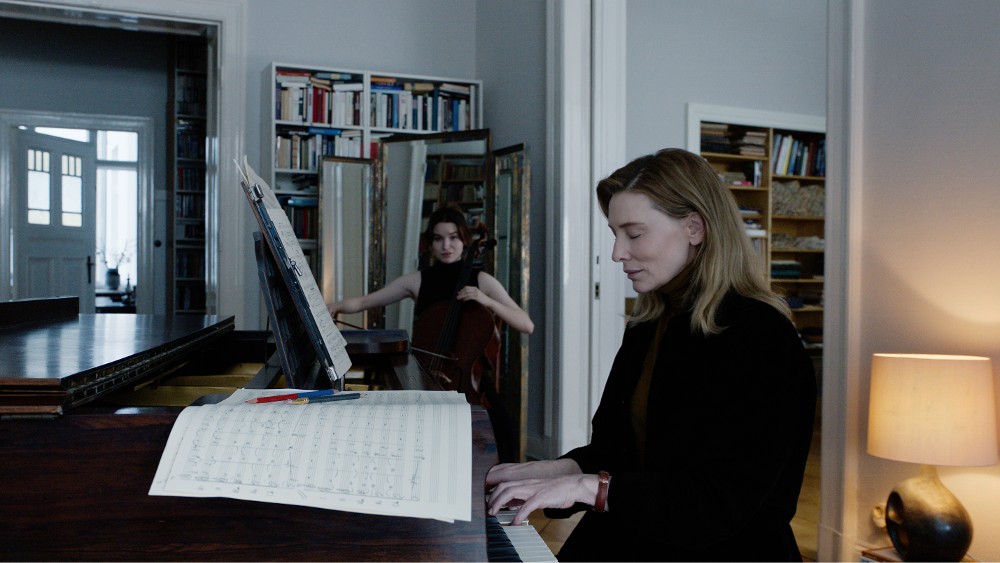
BTL: Could you talk about that last tracking shot in Asia a little bit?
Hoffmeister: What I absolutely loved about the script [is that] you have this film about classical music and then suddenly you find yourself in Southeast Asia [where] she’s conducting this orchestra. And then suddenly it ends with this line, [and] I felt absolutely in love with the script at that point, and I thought, ‘What an amazing way to end the film.’
It says, “Sisters and brothers of the Fifth Fleet, it’s time I keep my farewell brief. Never was much with words. Once you bought this ship, there’s no turning back. The next ground your feet touch will be that of the new world. If any of you have lost your nerve, then step away now and let no one judge you.”
And after that film, after that journey of the character, the last line is “let no one judge you.” [and] it’s [said to] fans of this game called Monster Hunter.
It was scripted that the camera would track along [with] them, and it was exactly what we did. But again, it was very carefully planned. Todd was very adamant that it was one shot and we didn’t want the camera to move in any form. It had to be a completely lateral movement, so again, we got one of those stereoscopic cranes called the technocrane. We had to dismantle it [and] put it back together in the cinema. That was done, like, days before, because they had to build a platform to wheel the thing into the position where it was prior. We had actually tested it on a parking lot, setting up stools and chairs to really make sure that it would hold for the time and that the camera would never travel. [We] set it up and then we filled the cinema with people and then we just worked and worked and worked until the shot was perfect.
And that was it; it was just that shot. And it was, ironically, the last shot we did and it was such a feeling of achievement because Southeast Asia was a revelation in many ways because [that’s where] the film loosens up its visual precision. I embraced more [of] the cacophony of lights [and] the colors.
I always felt you needed to feel the heat, the sweat, and there are other parts of life that she’s suddenly exposed to, and it was exactly [like] that [for us]. We got there [at] the end of the shoot and we had a few days to prep and then we shot in five days and it was absolutely remarkable to shoot.
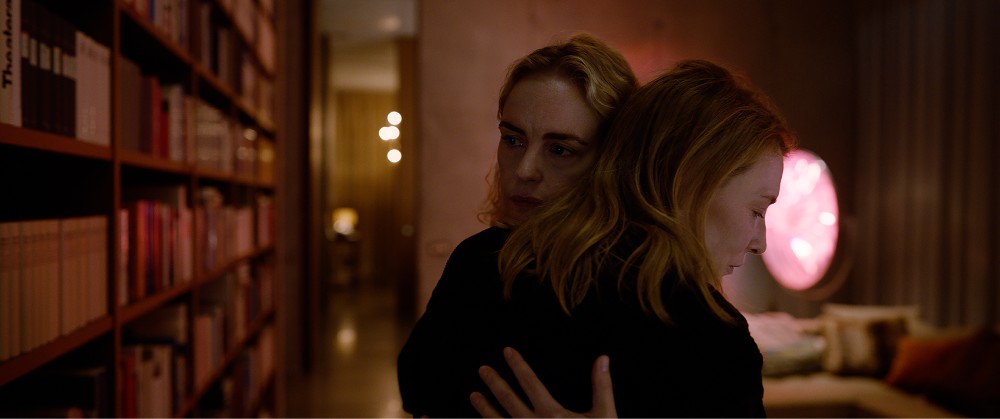
BTL: Do you have a favorite scene or shot?
Hoffmeister: That’s a hard question. That’s like asking somebody which one of their kids they love most. I’ll tell you one thing that really stuck with me, and it’s a very simple shot, but I loved [it] when it happened. There’s a scene when Cate Blanchett opens the door to the neighbor. They are selling the apartment and they are actually complaining because she’s doing the music and they want to know when she’s not there so they can show potential buyers the apartment, and she just looks at them, and then she starts laughing. And that laugh sticks with me to this very day because she is so warm and almost on the verge of hysteria, but not really. She’s just letting loose and she’s completely at ease with herself.
Those shots are simple; it’s basically [shot from] the hallway with the door open, so you set up the light and you make sure that there’s enough exposure on her face and that it all feels natural. I’ve done shots in doorways many, many times but again, that’s the beauty of film. And then she opens the door and she does that performance and I thought, ‘That’s just remarkable’ because she really gives the character such depth in that moment, you know?
And then [in] the next scene, another shot that I love is when she comes around with the accordion [and] she goes, [singing] “this apartment is for sale.” [But] no, I can’t choose one [scene or shot].
BTL: I’ll end on Cate Blanchett since everyone’s talking about her performance in this film. Earlier, you talked about working with her a little bit, but can I get your impression of her performance, seeing as you were the one who got to frame her for this nearly three-hour-long film?
Hoffmeister: What I can say is… what is amazing [about] when you work with an actor [is] the absolute determination to explore vulnerability and [an] absolute true understanding of the filming process as a technical process. And then, I think, to me as a cinematographer, it’s like winning the lottery because there are lots of people you know [who] might explore vulnerability or [who] might be dedicated to how they define the process, but to have an actor that does all three and understands the filmic process in terms of [the fact] that it’s a process that supports the performance as well as it sometimes needs to support the film and disregard the performance, but this also has technical implications. That’s a perfect situation [and] I feel very privileged to have photographed [TÁR].
TÁR had its world premiere at the Venice Film Festival and is still playing in select theaters, though it’s also available to rent or buy on VOD platforms.





